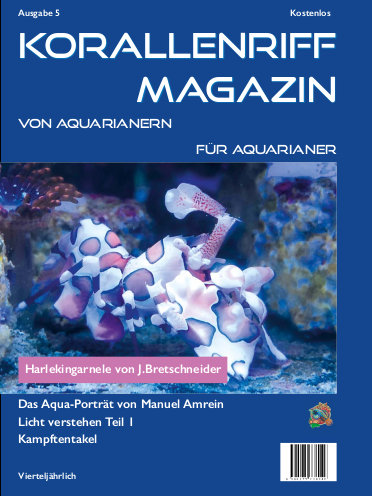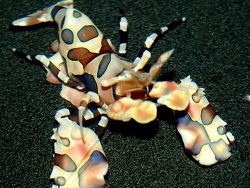Info
Halek shrimps are very beautifully colored (depending on their origin) and are probably also interesting to observe. If the fish are not too large, the shrimps will sit in the open, otherwise they prefer shelter under rocks and caves.
However, it is advisable to keep them in pairs "if at all", as they also live in pairs in the wild. The male feeds his female when there is a large piece of food.
Socialization
Small sea urchins with short spines should not be present in the aquarium, as their little feet may be nibbled off. Diademed sea urchins can fend off attacks well with their long spines.
Fromia nodosa and whip starfish are not eaten. Large wrasses and snappers are the predators and should not be kept together.
Aquarium conditions
Harlequin shrimps (including pairs) need a cave that they use as a hiding place for feeding and resting. If the current in the aquarium is too strong, the shrimp will look for a quiet place that may not be suitable for observation.
They are particularly sensitive to other shrimps and do not tolerate very high nitrate levels. A job supply is absolutely essential so that regular molting can take place without any problems.
Food
This bizarre little shrimp feeds exclusively on starfish and also searches for food during the day. It is most commonly seen feeding on Linckia multifora or Linckia laevigata, but will occasionally feed on other species including the juvenile cushion stars Culcita novaeguineae, Culcita schmideliana as well as Culcita sp. and even the crown-of-thorns, Acanthaster planci is eaten. The sand-dwelling Archaster angulatus and Archaster typicus are not safe from stalking either, as they can smell their food and are very determined to find the starfish when they emerge from the sand.
You can buy frozen starfish in specialized stores, which can then be divided and fed one starfish arm per shrimp every week.
Substitute food or use against pests:
The shrimp is often used to control a goosefoot starfish - Aquilonastra plague.
Attention, food specialist, only eats starfish! Cannot be kept otherwise and eventually starves to death.
If the shrimps are used so that the many goosefoot starfish are eaten, the following should be observed:
The number of starfish sighted is usually twice to three times as high.
One shrimp eats approx. 20 - 40 of the small starfish within one week, depending on the size of the shrimp. This means that even when using large tanks, everything is usually eaten after a few months. It is best to pass on the shrimps or ask aquarist friends if they have goosefoot starfish and collect them.
When feeding the small starfish individually, you should expect 2 - 4 per day and perhaps a frozen starfish arm once a month. A pair of harlequin shrimps can eat up to 15 small Asterina starfish per day if they are hungry.
Larger live starfish can feed the harlequin shrimp for up to 2 weeks, during which time the starfish will live to the end. However, not all of the starfish will be eaten and the rest will rot if it is not removed from the aquarium.
The life expectancy of shrimps kept in an aquarium is between 2 and 3 years, depending on how balanced the diet is.
The best breeding results are achieved by keeping them in a larval gyre with a constant laminar flow.
Synonyms:
Hymenocera elegans Heller, 1861
Hymenocera elegans Heller, 1862
Hymenocera latreillii Sharp, 1893







 Scott & Jeanette Johnson, Kwajalein Unterwater
Scott & Jeanette Johnson, Kwajalein Unterwater





















